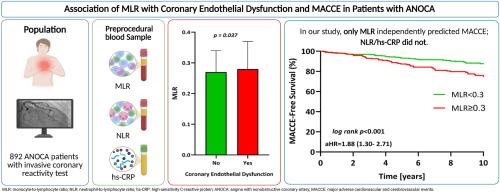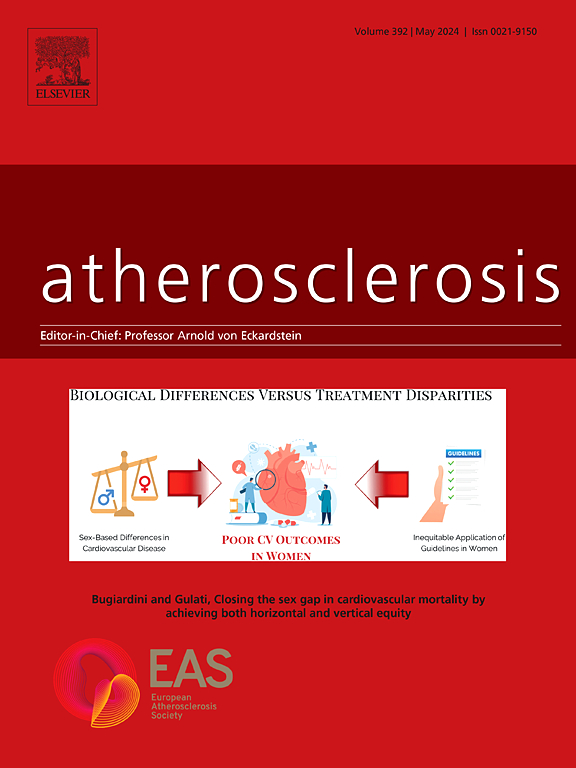Association of monocyte-to-lymphocyte ratio with coronary endothelial dysfunction and cardiovascular events in patients with angina and nonobstructive coronary artery disease
IF 5.7
2区 医学
Q1 CARDIAC & CARDIOVASCULAR SYSTEMS
引用次数: 0
Abstract
Background
Coronary endothelial dysfunction (CED) is regarded as an early stage of atherosclerosis. Inflammation plays a key role in the mechanism and progression of atherosclerosis, but its clinical utility in the initial phase is less clear.
Methods
Patients with angina and nonobstructive coronary artery disease who underwent coronary reactivity testing at the Mayo Clinic between 1997 and 2021 were enrolled. Endothelium-dependent microvascular dysfunction was a <50 % change in coronary blood flow, and endothelium-dependent epicardial dysfunction was a < −20 % change in epicardial arterial diameter, both with acetylcholine. Endothelium-independent microvascular dysfunction was a coronary flow reserve <2.5 with adenosine, and endothelium-independent epicardial dysfunction was a <20 % change in cross-sectional area after nitroglycerin. Preprocedural monocyte-to-lymphocyte ratio (MLR), neutrophil-to-lymphocyte ratio (NLR), and hs-CRP were used for major adverse cardiovascular and cerebrovascular events (MACCE) prediction.
Results
In 892 enrolled patients, with a median age of 52[43–61] years, 31 % were male. MLR was significantly higher in patients with endothelium-dependent epicardial (0.281 vs. 0.268, p = 0.042) and microvascular dysfunction (0.280 vs. 0.265, p = 0.015). However, no significant MLR differences were observed in patients with endothelium-independent epicardial or microvascular dysfunction.
In a 10-year follow-up, in univariate Cox Regression, higher MLR, NLR and hs-CRP levels were associated with higher MACCE. However, in multivariate Cox Regression for traditional risk factors, only MLR remained a significant independent predictor of MACCE (HR = 1.88, 95 %CI = 1.30–2.71, p < 0.001).
Conclusions
CED is associated with higher levels of MLR. Elevated MLR is independently linked to higher MACCE and may offer potential for early-stage atherosclerosis risk assessment.

心绞痛和非阻塞性冠状动脉疾病患者单核细胞与淋巴细胞比值与冠状动脉内皮功能障碍和心血管事件的关系
背景:冠状动脉内皮功能障碍(CED)被认为是动脉粥样硬化的早期阶段。炎症在动脉粥样硬化的机制和进展中起着关键作用,但其在初始阶段的临床应用尚不清楚。方法:纳入1997年至2021年间在梅奥诊所接受冠状动脉反应性检测的心绞痛和非阻塞性冠状动脉疾病患者。结果:892例入组患者中位年龄为52岁[43-61],31%为男性。内皮依赖性心外膜患者(0.281 vs. 0.268, p = 0.042)和微血管功能障碍患者(0.280 vs. 0.265, p = 0.015)的MLR显著升高。然而,在内皮不依赖性心外膜或微血管功能障碍患者中,MLR无显著差异。在10年的随访中,单变量Cox回归分析显示,较高的MLR、NLR和hs-CRP水平与较高的MACCE相关。然而,在传统危险因素的多变量Cox回归中,只有MLR仍然是MACCE的显著独立预测因子(HR = 1.88, 95% CI = 1.30-2.71, p)。结论:CED与较高水平的MLR相关。MLR升高与MACCE升高独立相关,可能提供早期动脉粥样硬化风险评估的潜力。
本文章由计算机程序翻译,如有差异,请以英文原文为准。
求助全文
约1分钟内获得全文
求助全文
来源期刊

Atherosclerosis
医学-外周血管病
CiteScore
9.80
自引率
3.80%
发文量
1269
审稿时长
36 days
期刊介绍:
Atherosclerosis has an open access mirror journal Atherosclerosis: X, sharing the same aims and scope, editorial team, submission system and rigorous peer review.
Atherosclerosis brings together, from all sources, papers concerned with investigation on atherosclerosis, its risk factors and clinical manifestations. Atherosclerosis covers basic and translational, clinical and population research approaches to arterial and vascular biology and disease, as well as their risk factors including: disturbances of lipid and lipoprotein metabolism, diabetes and hypertension, thrombosis, and inflammation. The Editors are interested in original or review papers dealing with the pathogenesis, environmental, genetic and epigenetic basis, diagnosis or treatment of atherosclerosis and related diseases as well as their risk factors.
 求助内容:
求助内容: 应助结果提醒方式:
应助结果提醒方式:


